An Enhanced Heterogeneous Gateway-Based Energy-Aware Multi-Hop Routing Protocol for Wireless Sensor Networks
Abstract
:1. Introduction
- Heterogeneity has been introduced in the existing MGEAR: we have introduced heterogeneous nodes of different energy levels to the existing scheme, especially in regions 3 and 4 which, to the best of our knowledge, have not been employed before. These nodes have higher energy than the homogeneous ones used in the existing scheme and therefore can transmit data effectively for a long period of time
- Cluster heads are selected based on only residual energy, because heterogeneous nodes are deployed in Regions 3 and 4. These nodes give a better supporting role for long periods and provide a better stability period than the homogeneous nodes deployed in the case of the models in [25,33]. This is to prevent the weak nodes from being chosen as cluster heads, as they would not transmit data effectively.
- In the proposed scheme, both the direct and multi-hop communication technique have been employed from Region 4 to the BS, which has not happened in [25,33]. This technique reduces the energy consumption of the nodes by preventing unnecessary data transmission by the distant nodes to the distant Base station.
2. Proposed Routing Scheme
2.1. Proposed Network Model
- ►
- The network can be subdivided in four subnetworks. located in Regions 1, 2, 3, and 4 as shown in Figure 1.
- ►
- There exists at least one node in Region 4 connected with a node in Region 3.
- ►
- The gateway is in Region 2 and is connected to the BS.
- ►
- The gateway is connected with the base station.
- ►
- Each node in Region 1 is connected to the base station.
- ►
- All nodes in Regions 3 and 4 are not connected with the base station.
2.2. The Routing Scheme
- The setup phase. It consists of allocating nodes in 4 Regions as well as election of the cluster heads.
- The steady phase. It relates to how data are transmitted among the nodes within the four regions. The energy involved in this data transmission is mostly determined in this phase.
2.2.1. Setup Phase
| Algorithm 1: The set up algorithm. |
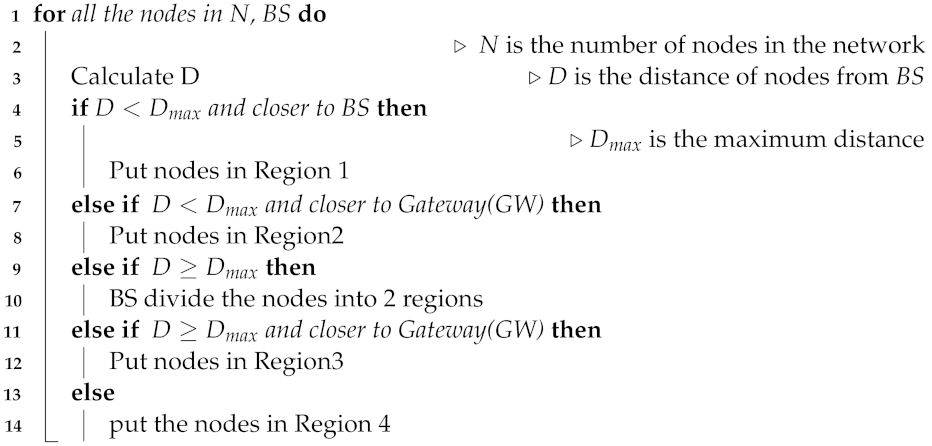 |
2.2.2. Steady Phase
| Algorithm 2: Selection of in Regions 3 and 4 and data transmission. |
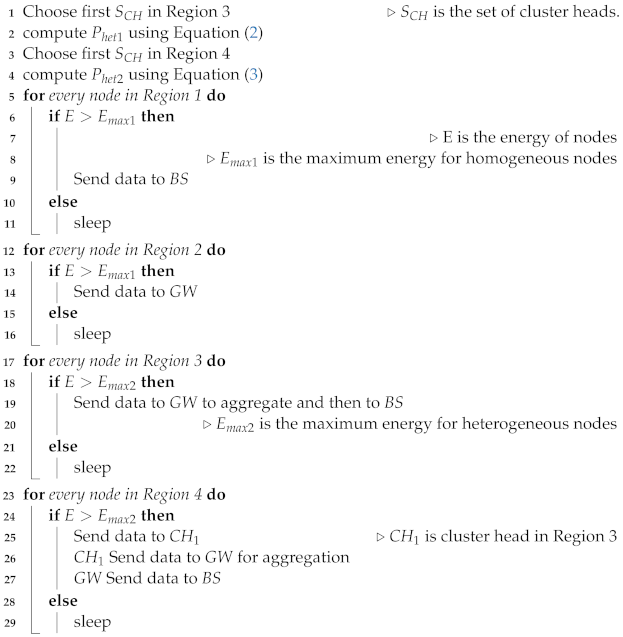 |
3. Simulation Results and Analysis
- Number of alive nodes per cluster round. It indicates the number of nodes alive from the network for every cluster round, and this depends on the availability of energy remaining in the network. A routing algorithm is more efficient if it can keep several nodes alive after many routing rounds.
- Number of dead nodes per cluster round. As a result of changing energy, it levels inside the network during network survival time. This also indicates the possible lifetime remaining of the network. A routing scheme is more efficient if it reduces the number of dead nodes in each cluster.
- Throughput. It means the numbers of packets sent to the BS by the nodes in each round. The throughput really shows the effective energy utilization corresponding to the underlying routing algorithm.
- Packets received. indicates the actual packets acknowledged by BS. A routing scheme is more efficient if it maximizes the number of delivered packets to the destination (base station in our case).
- The residual energy of the network. It helps to analyze the energy consumption of nodes in each round. In many cases, a routing algorithm which ensures less energy consumption is considered to be more efficient.
4. Conclusions
Author Contributions
Funding
Institutional Review Board Statement
Informed Consent Statement
Data Availability Statement
Conflicts of Interest
References
- Tuyishimire, E.; Adiel, I.; Rekhis, S.; Bagula, B.A.; Boudriga, N. Internet of things in motion: A cooperative data muling model under revisit constraints. In Proceedings of the 2016 Intl IEEE Conferences on Ubiquitous Intelligence & Computing, Advanced and Trusted Computing, Scalable Computing and Communications, Cloud and Big Data Computing, Internet of People, and Smart World Congress (UIC/ATC/ScalCom/CBDCom/IoP/SmartWorld), Toulouse, France, 18–21 July 2016; pp. 1123–1130. [Google Scholar]
- Ismail, A.; Bagula, B.A.; Tuyishimire, E. Internet-of-things in motion: A uav coalition model for remote sensing in smart cities. Sensors 2018, 18, 2184. [Google Scholar] [CrossRef] [PubMed] [Green Version]
- Bagula, A.; Tuyishimire, E.; Wadepoel, J.; Boudriga, N.; Rekhis, S. Internet-of-things in motion: A cooperative data muling model for public safety. In Proceedings of the 2016 Intl IEEE Conferences on Ubiquitous Intelligence & Computing, Advanced and Trusted Computing, Scalable Computing and Communications, Cloud and Big Data Computing, Internet of People, and Smart World Congress (UIC/ATC/ScalCom/CBDCom/IoP/SmartWorld), Toulouse, France, 18–21 July 2016; pp. 17–24. [Google Scholar]
- Ismail, A.; Tuyishimire, E.; Bagula, A. Generating dubins path for fixed wing uavs in search missions. In International Symposium on Ubiquitous Networking; Springer: Berlin/Heidelberg, Germany, 2018; pp. 347–358. [Google Scholar]
- Las Fargeas, J.; Kabamba, P.; Girard, A. Cooperative surveillance and pursuit using unmanned aerial vehicles and unattended ground sensors. Sensors 2015, 15, 1365–1388. [Google Scholar] [CrossRef] [PubMed] [Green Version]
- Tuyishimire, E.; Bagula, A.; Rekhis, S.; Boudriga, N. Cooperative data muling from ground sensors to base stations using UAVs. In Proceedings of the 2017 IEEE Symposium on Computers and Communications (ISCC), Heraklion, Greece, 3–6 July 2017; pp. 35–41. [Google Scholar]
- Tuyishimire, E.; Bagula, A.; Rekhis, S.; Boudriga, N. Real-time data muling using a team of heterogeneous unmanned aerial vehicles. arXiv 2019, arXiv:1912.08846. [Google Scholar]
- Han, G.; Liu, L.; Jiang, J.; Shu, L.; Hancke, G. Analysis of energy-efficient connected target coverage algorithms for industrial wireless sensor networks. IEEE Trans. Ind. Inform. 2015, 13, 135–143. [Google Scholar] [CrossRef]
- Tuyishimire, E. Cooperative Data Muling Using a Team of Unmanned Aerial Vehicles. Ph.D. Thesis, University of the Western Cape, Cape Town, South Africa, 2019. [Google Scholar]
- Tuyishimire, E.; Bagula, B.A. A Formal and Efficient Routing Model for Persistent Traffics in the Internet of Things. In Proceedings of the 2020 Conference on Information Communications Technology and Society (ICTAS), Durban, South Africa, 11–12 March 2020; pp. 1–6. [Google Scholar]
- Tuyishimire, E. Internet of Things: Least Interference Beaconing Algorithms. Master’s Thesis, University of Cape Town, Cape Town, South Africa, 2014. [Google Scholar]
- John, T.O.; Ukwuoma, H.C.; Danjuma, S.; Ibrahim, M. Energy Consumption in Wireless Sensor Network. Energy 2016, 7, 63–67. [Google Scholar]
- Sabri, A.; Al-Shqeerat, K. Hierarchical cluster-based routing protocols for wireless sensor networks-a survey. Int. J. Comput. Sci. Issues (IJCSI) 2014, 11, 93. [Google Scholar]
- Tuyishimire, E.; Bagula, A.; Ismail, A. Clustered data muling in the internet of things in motion. Sensors 2019, 19, 484. [Google Scholar] [CrossRef] [Green Version]
- Abidoye, A.P. Energy Optimization for Wireless Sensor Networks Using Hierarchical Routing Techniques. Ph.D. Thesis, University of the Western Cape, Cape Town, South Africa, 2015. [Google Scholar]
- Tuyishimire, E.; Bagula, B.A.; Ismail, A. Optimal clustering for efficient data muling in the internet-of-things in motion. In International Symposium on Ubiquitous Networking; Springer: Berlin/Heidelberg, Germany, 2018; pp. 359–371. [Google Scholar]
- Sangaiah, A.K.; Sadeghilalimi, M.; Hosseinabadi, A.A.R.; Zhang, W. Energy consumption in point-coverage wireless sensor networks via bat algorithm. IEEE Access 2019, 7, 180258–180269. [Google Scholar] [CrossRef]
- Sangaiah, A.K.; Rostami, A.S.; Hosseinabadi, A.A.R.; Shareh, M.B.; Javadpour, A.; Bargh, S.H.; Hassan, M.M. Energy-Aware Geographic Routing for Real-Time Workforce Monitoring in Industrial Informatics. IEEE Internet Things J. 2021, 8, 9753–9762. [Google Scholar] [CrossRef]
- Abidoye, A.P.; Kabaso, B. Energy-efficient hierarchical routing in wireless sensor networks based on Fog Computing. EURASIP J. Wirel. Commun. Netw. 2021, 2021, 1–26. [Google Scholar] [CrossRef]
- Bagula, A.; Abidoye, A.P.; Zodi, G.A.L. Service-aware clustering: An energy-efficient model for the internet-of-things. Sensors 2016, 16, 9. [Google Scholar] [CrossRef] [PubMed] [Green Version]
- Heinzelman, W.R.; Chandrakasan, A.; Balakrishnan, H. Energy-efficient communication protocol for wireless microsensor networks. In Proceedings of the 33rd Annual Hawaii International Conference on System Sciences, Maui, HI, USA, January 2000; p. 10. [Google Scholar]
- Qing, L.; Zhu, Q.; Wang, M. Design of a distributed energy-efficient clustering algorithm for heterogeneous wireless sensor networks. Comput. Commun. 2006, 29, 2230–2237. [Google Scholar] [CrossRef]
- Sharma, N.; Verma, V. Heterogeneous LEACH protocol for wireless sensor networks. Int. J. Adv. Netw. Appl. 2013, 5, 1825. [Google Scholar]
- Elbhiri, B.; Saadane, R.; El fldhi, S.; Aboutajdine, D. Developed Distributed Energy-Efficient Clustering (DDEEC) for heterogeneous wireless sensor networks. In Proceedings of the 2010 5th International Symposium On I/V Communications and Mobile Network, Rabat, Morocco, 30 September–2 October 2010; pp. 1–4. [Google Scholar]
- Jibreel, F. Improved-gateway-based energy-aware multi-hop routing protocol for WSNs. Int. J. Innov. Sci. Res. Technol. 2018, 3, 625–630. [Google Scholar]
- Saini, P.; Sharma, A.K. Energy efficient scheme for clustering protocol prolonging the lifetime of heterogeneous wireless sensor networks. Int. J. Comput. Appl. 2010, 6, 30–36. [Google Scholar] [CrossRef]
- Jibreel, F. Improved Enhanced Distributed Energy Efficient Clustering (iE-DEEC) scheme for heterogeneous wireless sensor network. Int. J. Eng. Res. Adv. Technol. (IJERAT) 2019, 5, 6–11. [Google Scholar] [CrossRef]
- Jibreel, F.; Jibreel, F. Extended Threshold Stable Election Protocol for Wireless Sensor Networks. N. Am. Acad. Res. 2019, 2, 131–140. [Google Scholar]
- Jibreel, F.; Gbolagade, K.; Daabo, M. Servant-LEACH Energy Efficient Cluster-Based Routing Protocol for Large Scale Wireless Sensor Network. Int. J. Eng. Res. Technol. (IJERT) 2018, 9, 171–176. [Google Scholar] [CrossRef]
- Jibreel, F. Gateway–based Threshold Distributed Energy Efficient Clustering (G-TDEEC). Int. J. Comput. Appl. 2019, 182, 43–46. [Google Scholar] [CrossRef]
- Jibreel, F.; Daabo, M.I.; Gbolagade, K.A. DistanceDistributed Energy Efficient Clustering (D-DEEC) Routing Protocol. In Proceedings of the 13th International Multi-Conference on ICT Applications, Lisbon, Portugal, 21–23 June 2019; pp. 49–53. [Google Scholar]
- Kaur, G.; Kaur, S. Enhanced m-gear protocol for lifetime enhancement in wireless clustering system. Int. J. Comput. Appl. 2016, 147. [Google Scholar] [CrossRef]
- Jibreel, F.; Daabo, M.; Gbolagade, K. Gateway-stable election protocol for heterogeneous wireless sensor network. Asian J. Res. Comput. Sci. 2020, 5, 40–48. [Google Scholar] [CrossRef] [Green Version]
- Nadeem, Q.; Rasheed, M.B.; Javaid, N.; Khan, Z.A.; Maqsood, Y.; Din, A. M-GEAR: Gateway-based energy-aware multi-hop routing protocol for WSNs. In Proceedings of the 2013 Eighth International Conference on Broadband and Wireless Computing, Communication and Applications, Compiegne, France, 28–30 October 2013; pp. 164–169. [Google Scholar]
- Purkar, S.V.; Deshpande, R.S. Energy efficient clustering protocol to enhance performance of heterogeneous wireless sensor network: EECPEP-HWSN. J. Comput. Netw. Commun. 2018, 2018, 2078627. [Google Scholar]
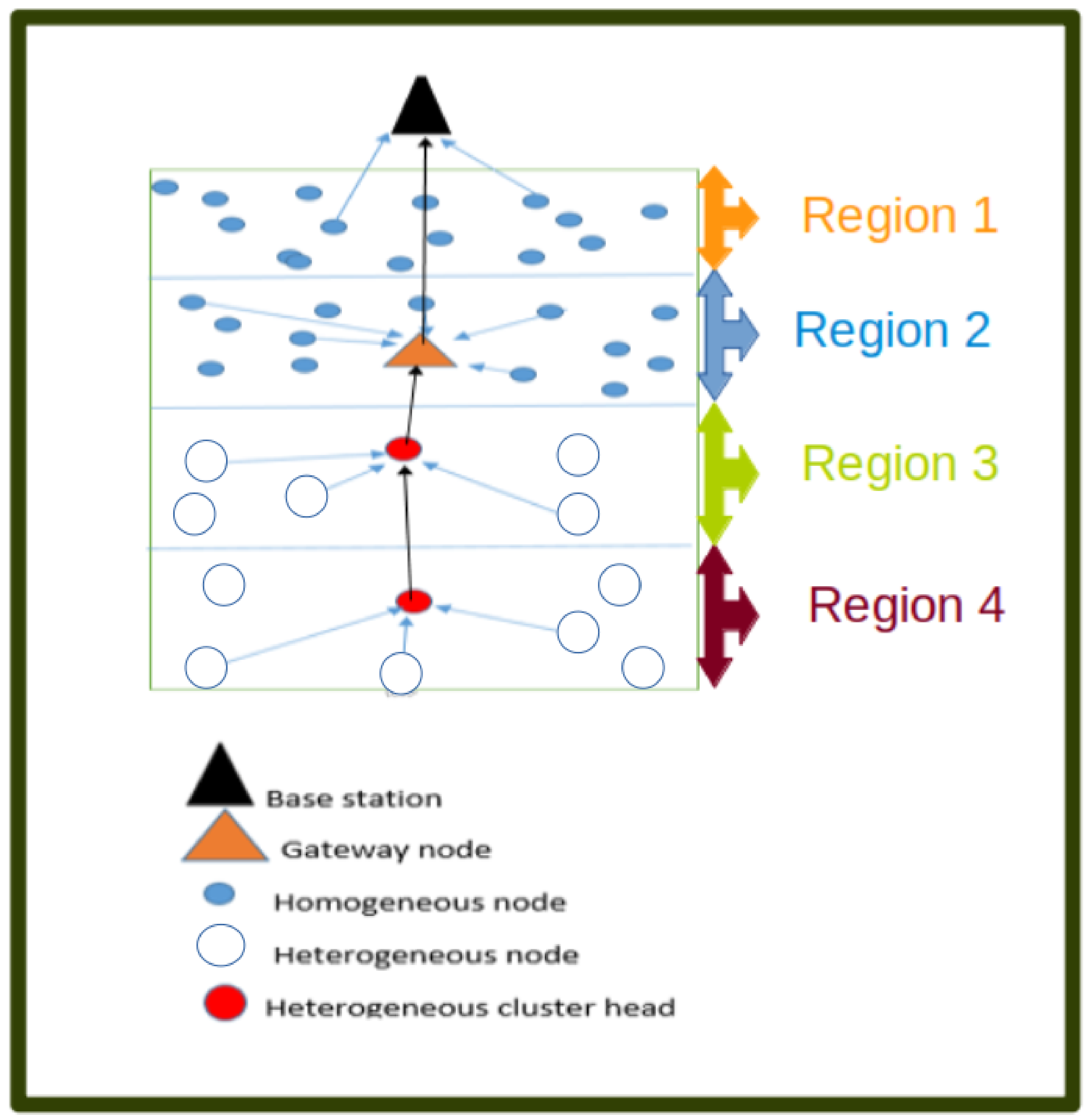
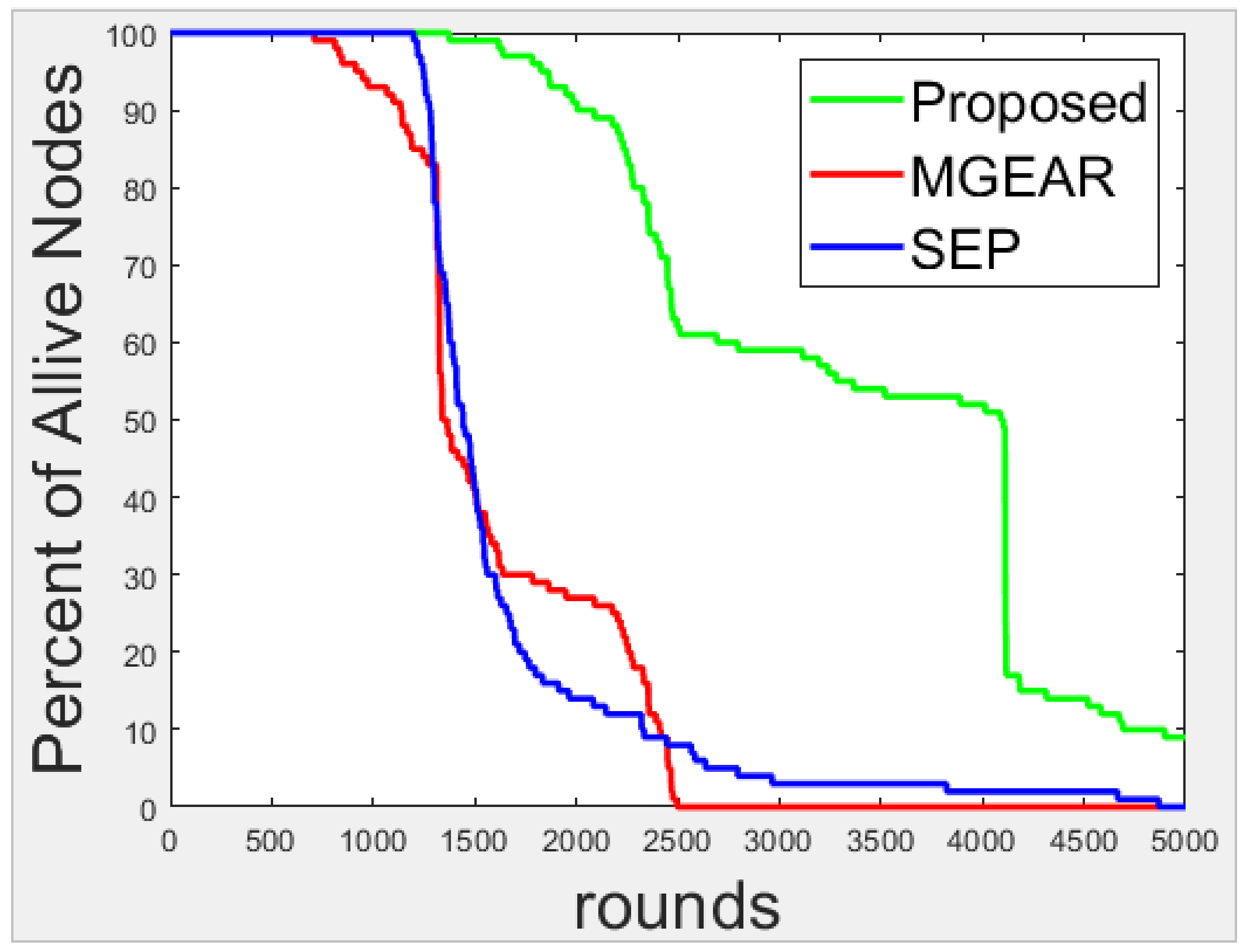
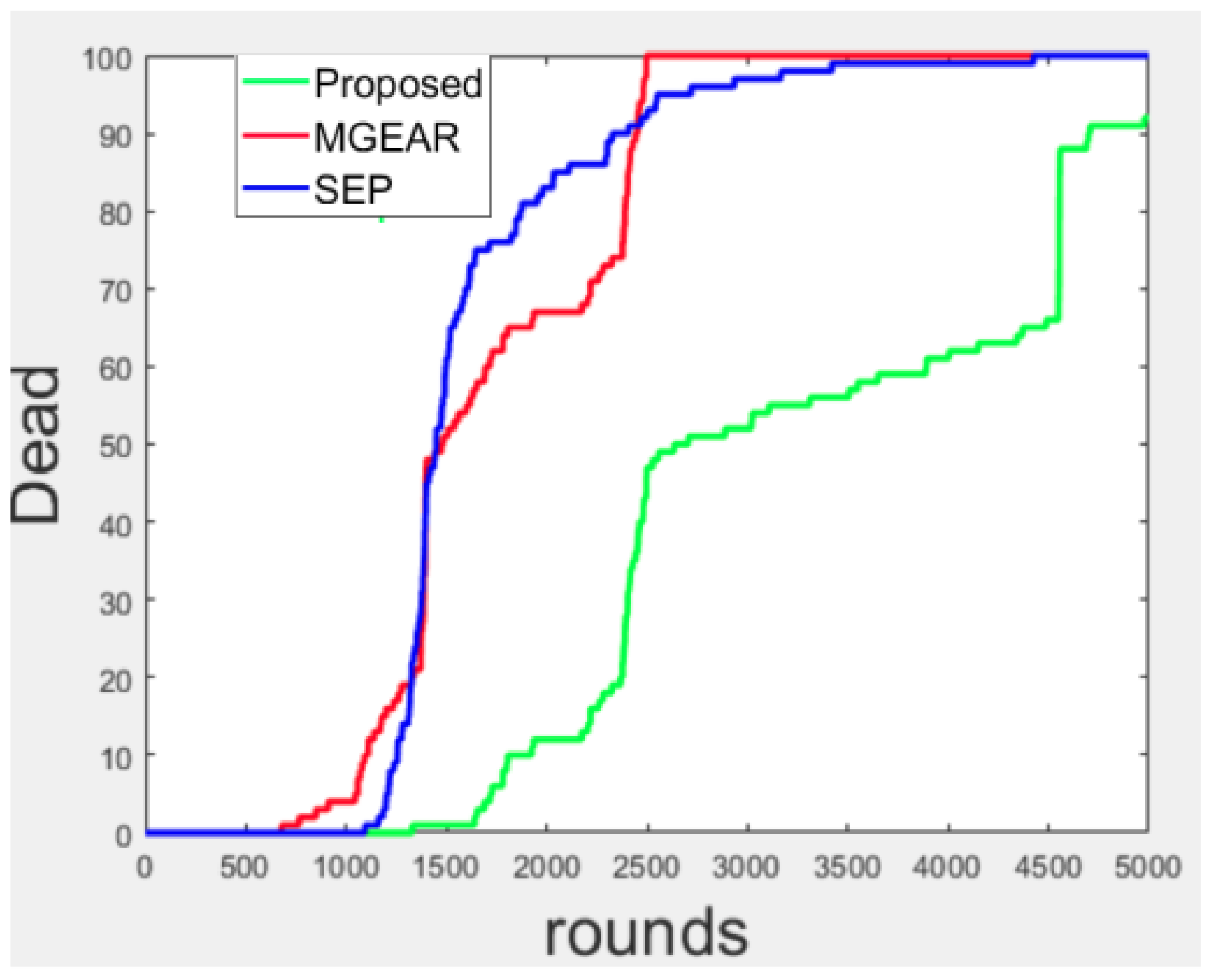
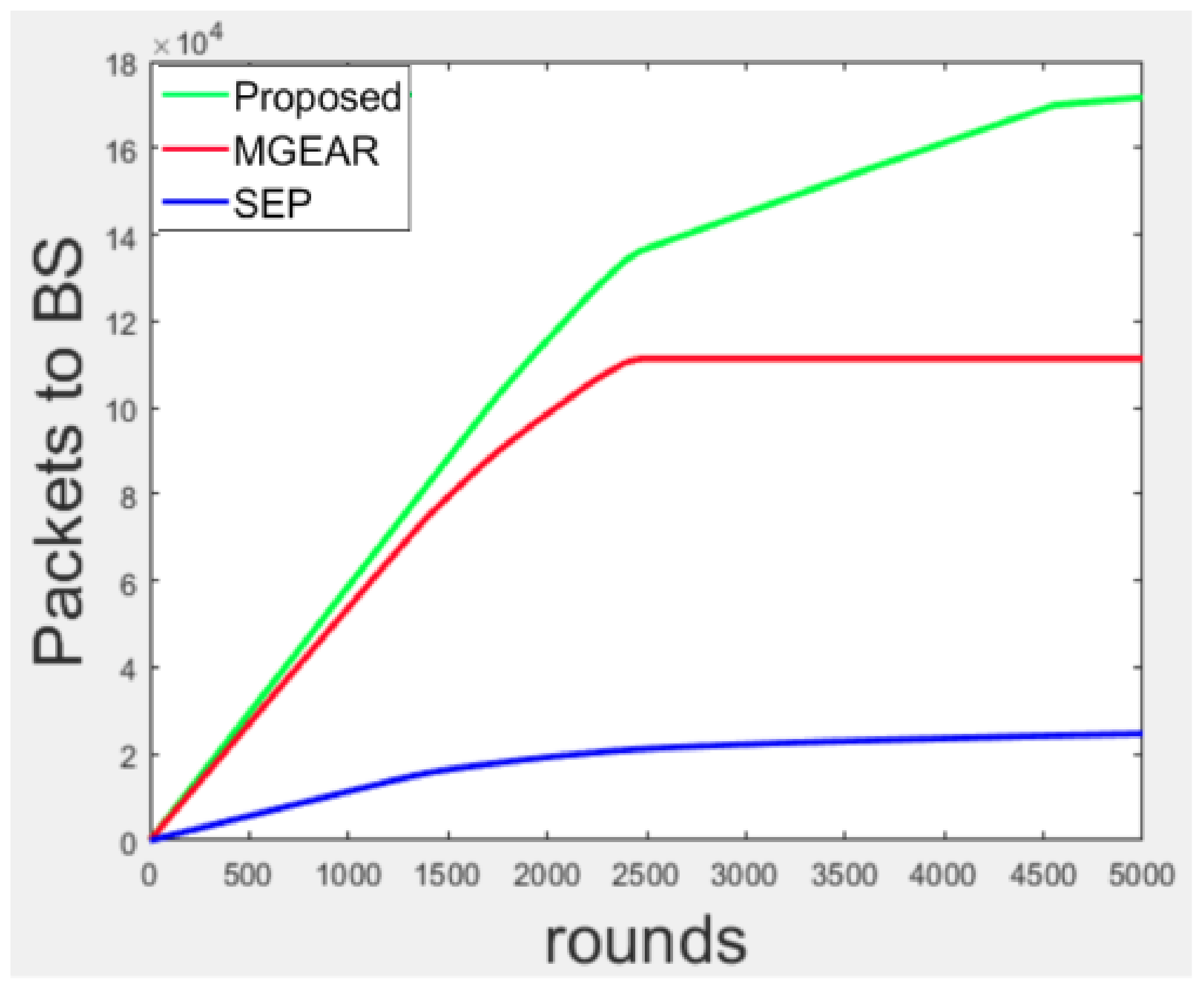
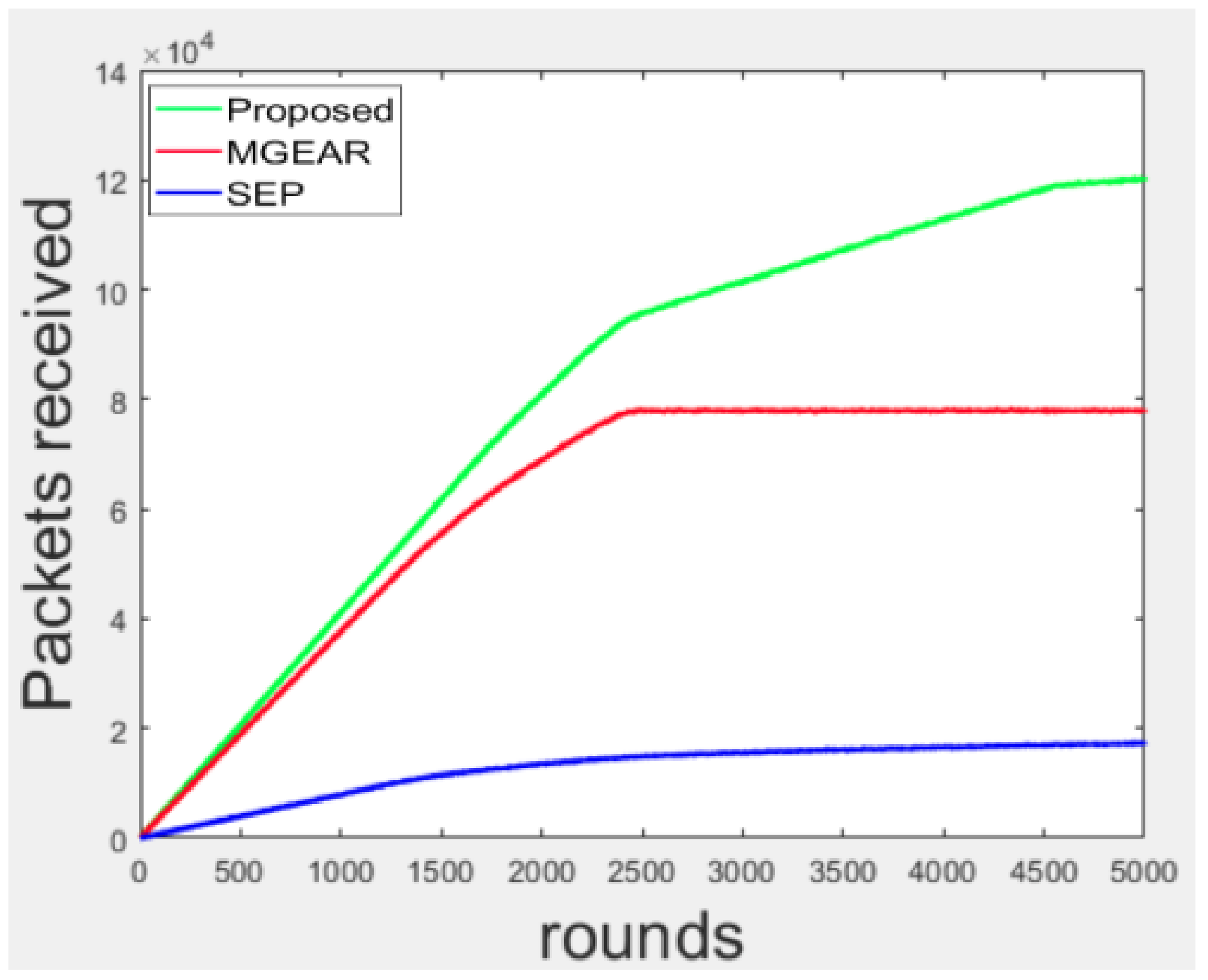
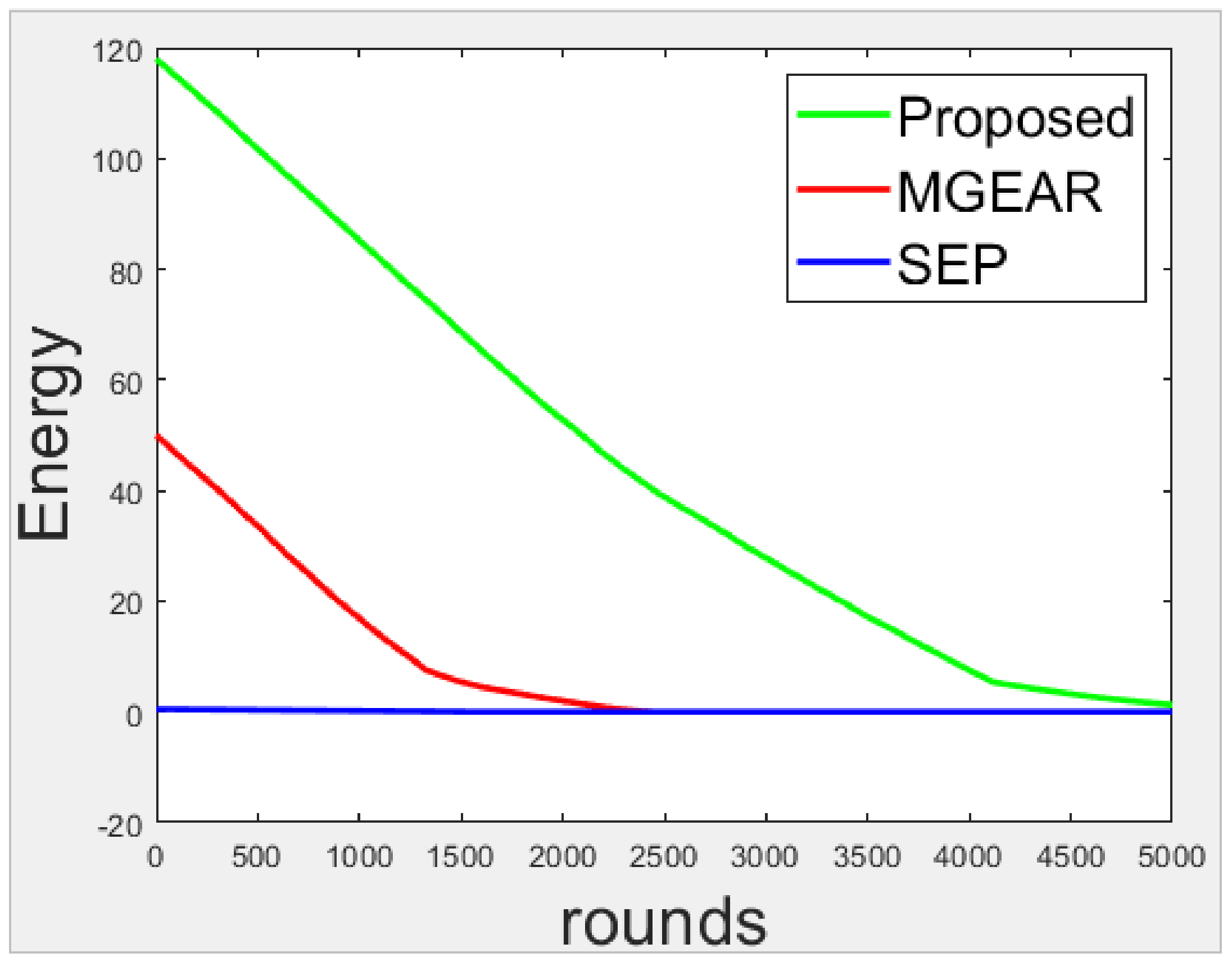
| Parameters | Values |
|---|---|
| Network field | |
| Number of nodes | 100 |
| Initial energy of normal nodes () | J |
| Message size | 4000 bits |
| 50 Nj/bit | |
| 10 Nj/bit/m | |
| Pj/bit/m | |
Publisher’s Note: MDPI stays neutral with regard to jurisdictional claims in published maps and institutional affiliations. |
© 2022 by the authors. Licensee MDPI, Basel, Switzerland. This article is an open access article distributed under the terms and conditions of the Creative Commons Attribution (CC BY) license (https://creativecommons.org/licenses/by/4.0/).
Share and Cite
Jibreel, F.; Tuyishimire, E.; Daabo, M.I. An Enhanced Heterogeneous Gateway-Based Energy-Aware Multi-Hop Routing Protocol for Wireless Sensor Networks. Information 2022, 13, 166. https://doi.org/10.3390/info13040166
Jibreel F, Tuyishimire E, Daabo MI. An Enhanced Heterogeneous Gateway-Based Energy-Aware Multi-Hop Routing Protocol for Wireless Sensor Networks. Information. 2022; 13(4):166. https://doi.org/10.3390/info13040166
Chicago/Turabian StyleJibreel, Fuseini, Emmanuel Tuyishimire, and Mohammed Ibrahim Daabo. 2022. "An Enhanced Heterogeneous Gateway-Based Energy-Aware Multi-Hop Routing Protocol for Wireless Sensor Networks" Information 13, no. 4: 166. https://doi.org/10.3390/info13040166
APA StyleJibreel, F., Tuyishimire, E., & Daabo, M. I. (2022). An Enhanced Heterogeneous Gateway-Based Energy-Aware Multi-Hop Routing Protocol for Wireless Sensor Networks. Information, 13(4), 166. https://doi.org/10.3390/info13040166






